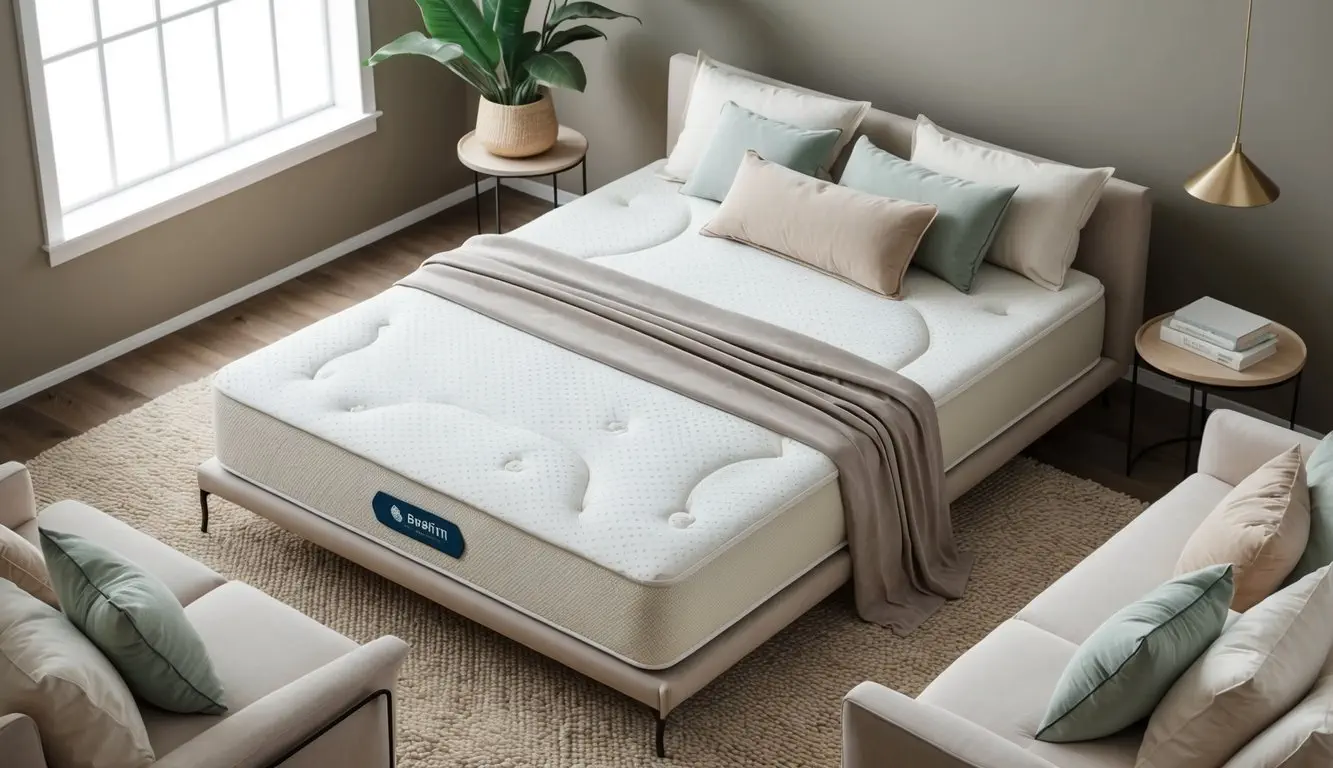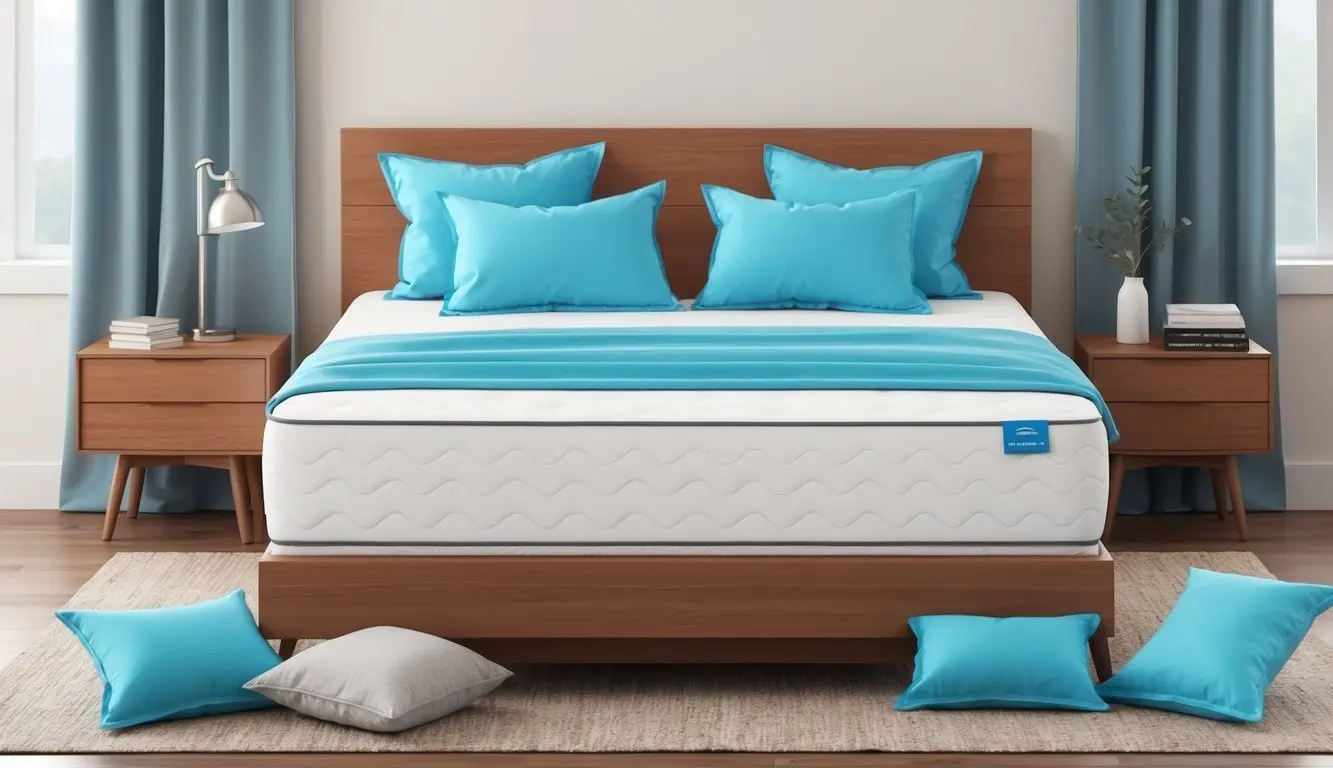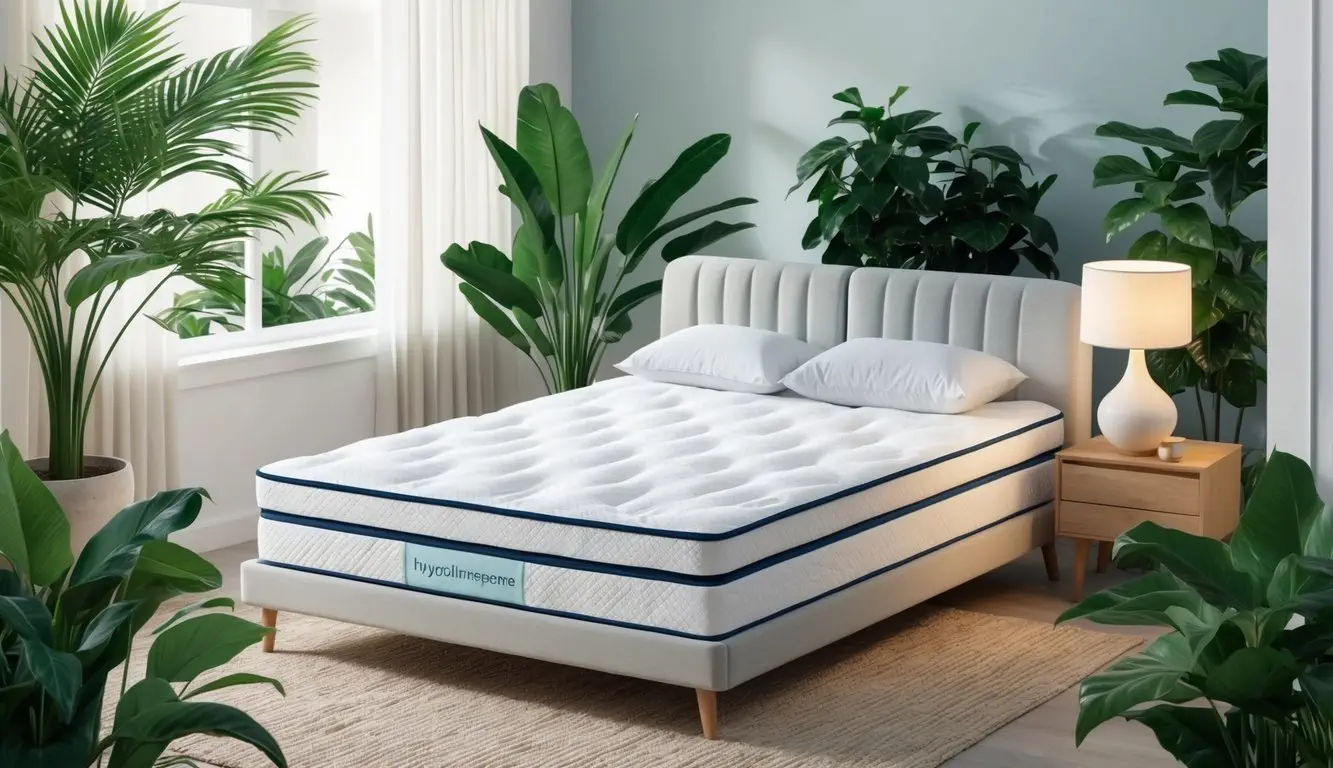Looking for a mattress that won’t trigger allergies? Hypoallergenic mattresses are designed to minimize allergens like dust mites, mold, and pet dander that can disrupt your sleep.

The best hypoallergenic mattresses use materials like natural latex, organic cotton, and specially treated memory foam to create a sleeping surface that resists common allergens. These mattresses often feature removable, washable covers for easy cleaning and maintenance.
Finding the right hypoallergenic mattress depends on your specific sensitivities and sleep preferences. Some people need complete protection from dust mites, while others may be more concerned about avoiding chemical off-gassing found in traditional mattresses.
Understanding Hypoallergenic Mattresses

Hypoallergenic mattresses provide critical protection for people with sensitivities to common bedroom allergens. These specialized sleep surfaces use materials and construction methods designed to minimize allergen buildup and create a healthier sleep environment.
Definition and Importance for Allergy Sufferers
A hypoallergenic mattress is specifically engineered to resist common allergens that trigger allergic reactions. For allergy sufferers, these mattresses can significantly improve sleep quality and overall health.
Traditional mattresses often harbor dust mites, mold, and other allergens that cause symptoms like sneezing, congestion, and skin irritation. Hypoallergenic options use materials that naturally repel these triggers.
People with asthma and chronic allergies benefit most from these specialized sleep surfaces. Studies show that using hypoallergenic bedding can reduce nighttime symptoms by up to 60%.
These mattresses typically feature protective barriers or use materials like natural latex, certain memory foams, or specially treated fabrics that resist allergen accumulation.
Types of Allergens Addressed
Hypoallergenic mattresses target several key allergens that commonly disrupt sleep:
Dust Mites: These microscopic creatures feed on dead skin cells and thrive in traditional mattresses. Hypoallergenic options use tight-weave covers or natural repellent materials.
Mold and Mildew: Moisture-resistant materials prevent the growth of these allergens. Many hypoallergenic mattresses include breathable layers that wick away humidity.
Pet Dander: Special barrier fabrics prevent pet allergens from penetrating the mattress core.
Chemical Sensitivities: For those with chemical sensitivities, organic or low-VOC mattresses avoid harsh chemicals, adhesives, and flame retardants that can trigger reactions.
Most quality hypoallergenic mattresses address multiple allergen concerns simultaneously, providing comprehensive protection for sensitive individuals.
Key Features of Hypoallergenic Mattresses

Hypoallergenic mattresses combine special materials and technologies to create a sleep environment that minimizes allergen exposure. These mattresses offer protection against common triggers while maintaining comfort and support.
Materials and Construction
Hypoallergenic mattresses typically use materials that naturally resist allergens and dust mites. Memory foam stands out as a popular choice due to its dense structure that prevents dust mites from penetrating the mattress. These mattresses often have cell structures too tight for allergens to infiltrate.
Latex mattresses provide another excellent option for allergy sufferers. Natural latex is inherently antimicrobial and resistant to dust mites and mold. Many manufacturers offer certified organic latex options for those seeking eco-friendly alternatives.
Some hypoallergenic mattresses incorporate wool or cotton barriers that are naturally breathable while still providing protection. These materials regulate temperature and wick away moisture that might otherwise encourage dust mite growth.
The construction typically includes sealed seams and allergen-proof covers that create a complete barrier against potential irritants.
Allergen-Resistant Technologies
Modern hypoallergenic mattresses employ several allergen-resistant technologies to enhance protection. Many feature specialized covers with tightly woven fabrics that block microscopic particles while remaining comfortable against the skin.
Antimicrobial treatments prevent the growth of bacteria, mold, and mildew that can trigger allergic reactions. These treatments are typically applied to the mattress materials during manufacturing.
Some advanced models incorporate air purification layers that actively filter allergens from the sleeping environment. These technologies can trap and neutralize airborne particles before they settle.
Moisture-wicking technologies are also common in hypoallergenic mattresses. They prevent the humid conditions that dust mites need to thrive by drawing moisture away from the sleep surface.
Manufacturers often subject their materials to hot washing processes that eliminate potential allergens before the mattress is assembled.
Benefits of a Hypoallergenic Mattress

Hypoallergenic mattresses provide significant health advantages for allergy sufferers and anyone seeking cleaner sleep. These specially designed beds address common allergen concerns while promoting better overall wellness.
Reduced Allergy Symptoms
Hypoallergenic mattresses are specifically engineered to resist common allergens like dust mites, pet dander, and pollen. These microscopic irritants often accumulate in traditional mattresses, triggering sneezing, congestion, and itchy eyes in sensitive individuals.
The dense structure of hypoallergenic materials creates a barrier that prevents allergens from penetrating deep into the mattress. Many models feature tightly woven covers that block dust mites from establishing colonies within the bedding.
For those with sensitive skin, these mattresses minimize contact with irritating substances that can cause rashes or eczema flare-ups. Many hypoallergenic options are also free from harsh chemicals and VOCs (volatile organic compounds) that can worsen respiratory issues.
Improved Sleep Quality
When allergy symptoms decrease, sleep quality naturally improves. Hypoallergenic mattresses help reduce nighttime congestion, coughing, and sneezing that typically disrupt sleep cycles.
Users often report falling asleep faster and experiencing fewer middle-of-the-night awakenings. This leads to more consistent deep sleep phases, which are essential for physical recovery and mental health.
Many hypoallergenic mattresses also offer excellent temperature regulation. Their breathable materials prevent the growth of mold and mildew, which thrive in warm, humid environments and can trigger allergic responses.
People with asthma particularly benefit from these specialized mattresses, as they reduce exposure to triggers that can cause nighttime breathing difficulties.
Durable and Long-Lasting
Hypoallergenic mattresses typically outlast conventional options. Their high-quality materials resist breakdown and compression that occurs in standard mattresses over time.
Most feature advanced foam or latex constructions that maintain their shape and supportive properties for 8-10 years or longer. This extended lifespan makes them a smart investment despite their sometimes higher initial cost.
The dense materials used in these mattresses resist the accumulation of body oils and moisture that can lead to premature deterioration. Many also include removable, washable covers that help maintain cleanliness throughout the mattress’s life.
Regular cleaning is simpler with hypoallergenic mattresses. Their resistant surfaces make vacuuming more effective at removing surface allergens like pet dander and pollen that settle on bedding.
Selecting the Right Hypoallergenic Mattress

Finding a hypoallergenic mattress requires attention to materials, construction, and your specific sensitivity needs. The right choice balances comfort with allergy protection while providing proper support for restful sleep.
Assessing Your Allergy Needs
Different allergy sufferers require different mattress solutions. Dust mite allergies benefit from mattresses with tight-woven covers that prevent these microscopic creatures from penetrating the surface.
Those with chemical sensitivities should look for certifications like CertiPUR-US® or GOLS (Global Organic Latex Standard) that verify low VOC emissions. These certifications ensure the mattress won’t off-gas harmful chemicals into your bedroom.
Keep a sleep journal to track how your symptoms respond to different environments. This information helps identify your specific triggers.
Consider consulting an allergist before making a significant mattress investment. They can provide personalized recommendations based on your allergy profile and sensitivity levels.
Comparing Mattress Types and Materials
Natural latex mattresses offer excellent hypoallergenic properties. They resist dust mites naturally and don’t harbor mold or mildew. However, those with latex allergies should avoid these models.
Memory foam mattresses with CertiPUR-US® certification provide a hypoallergenic option with minimal off-gassing. Their dense structure prevents allergen accumulation, though some lower-quality foams may emit chemicals when new.
Organic cotton and wool covers create natural barriers against allergens. These materials breathe well and resist moisture buildup that can lead to mold.
Hybrid mattresses combine supportive coils with hypoallergenic comfort layers. Look for models with allergen-resistant covers and certified foams.
| Mattress Type | Hypoallergenic Benefits | Potential Concerns |
|---|---|---|
| Natural Latex | Dust mite resistant, antimicrobial | Not suitable for latex allergies |
| Memory Foam | Dense structure blocks allergens | Some may off-gas initially |
| Organic Cotton/Wool | Natural barriers, breathable | May require special cleaning |
| Hybrid | Combines benefits of multiple materials | Varies by specific materials used |
Considering Mattress Firmness and Support
Mattress firmness affects both comfort and allergy management. Medium-firm to firm mattresses often collect fewer allergens because they have less depth for particles to penetrate.
Softness preferences vary by sleeping position. Side sleepers typically need slightly softer surfaces to accommodate shoulder and hip pressure points while maintaining proper spinal alignment.
Body weight influences firmness needs. Heavier individuals generally require firmer mattresses to prevent excessive sinking that can create pockets where allergens collect.
Test mattresses whenever possible. Many companies offer sleep trials ranging from 30-365 days, allowing you to ensure the mattress doesn’t trigger your allergies before fully committing.
Remember that support and comfort are equally important as hypoallergenic properties. A mattress that causes poor sleep due to discomfort or inadequate support will negatively impact your health regardless of its allergy protection.
Maintenance and Care for Hypoallergenic Mattresses

Proper maintenance of hypoallergenic mattresses helps extend their lifespan and maintain their allergen-resistant qualities. Regular cleaning routines and protective measures can significantly reduce allergen buildup and keep your sleeping environment healthy.
Regular Cleaning and Dusting
Hypoallergenic mattresses require consistent cleaning to maintain their allergen-fighting properties. Vacuuming the mattress surface weekly with a HEPA filter vacuum removes dust mites, dead skin cells, and other allergens that accumulate over time.
For deeper cleaning, sprinkle baking soda across the mattress surface and let it sit for 1-2 hours before vacuuming. This naturally neutralizes odors without harsh chemicals that might trigger allergic reactions.
Rotating the mattress every 3-6 months ensures even wear and prevents body impressions that can collect allergens. Some hypoallergenic mattresses should be flipped as well, though many modern designs are one-sided.
Follow manufacturer guidelines for specific cleaning instructions, as some materials require special care. Avoid steam cleaning memory foam or latex hypoallergenic mattresses, as excessive moisture can damage these materials.
Using Protective Covers
Allergen-proof mattress covers create a physical barrier between allergens and the mattress surface. These covers are typically made from tightly woven fabrics with pore sizes small enough to block dust mites and other microscopic allergens.
Types of Protective Covers:
- Hypoallergenic mattress protectors: Basic protection against common allergens
- Waterproof mattress protectors: Added protection against spills and moisture
- Full encasement covers: Complete protection, zipping around all six sides of the mattress
Wash protective covers every 1-2 weeks in hot water (at least 130°F) to kill dust mites and remove allergens. Replace covers showing signs of wear, as tears and stretched fabric reduce their effectiveness.
Quality mattress protectors maintain airflow while blocking allergens. This prevents the mattress from feeling hot or trapping humidity that could lead to mold growth.
Addressing Spills and Moisture
Quick action is crucial when dealing with spills on hypoallergenic mattresses. Moisture creates an ideal environment for mold, mildew, and dust mites to thrive.
For liquid spills:
- Blot (don’t rub) with clean, absorbent towels
- Apply a mild soap solution with a damp cloth
- Rinse by blotting with clean water
- Dry thoroughly with towels
- Allow to air dry completely before replacing bedding
Use a fan to speed drying time and prevent moisture from settling deep into the mattress. A dehumidifier in the bedroom helps control ambient moisture levels, especially in humid climates.
Monitor the mattress for any signs of mold or mildew, which appear as dark spots and may have a musty smell. If mold develops, consult professional cleaners who specialize in mattress restoration.
Complementary Hypoallergenic Bedding Options

A complete allergen-free sleep environment requires more than just a hypoallergenic mattress. The right bedding materials can significantly reduce exposure to common allergens and create a healthier sleep space.
Pillows and Comforters
Hypoallergenic pillows are essential for allergy sufferers. Memory foam pillows resist dust mites and mold growth due to their dense structure. Many brands now offer pillows with removable, washable covers for added protection.
Down alternative pillows provide the softness of traditional down without the allergens. These synthetic options are typically made from polyester microfibers that mimic down’s loft and feel.
For comforters, look for those with anti-bacterial treatments that inhibit microorganism growth. Bamboo-filled comforters offer natural resistance to bacteria and dust mites.
Hot water washing (130°F or higher) can eliminate most allergens from bedding. Select comforters labeled machine-washable for regular cleaning.
Many manufacturers now certify their products as hypoallergenic through independent testing, providing verification of their allergy-friendly claims.
Sheets and Blankets
Tightly woven fabrics create a physical barrier against dust mites and other allergens. Look for sheets with a thread count of at least 300 for adequate protection while maintaining breathability.
Recommended hypoallergenic sheet materials:
- Organic cotton
- Microfiber
- Bamboo
- TENCEL™ (lyocell)
These materials resist bacterial growth and are less likely to trigger reactions than conventional bedding. Bamboo sheets offer natural antimicrobial properties and excellent moisture-wicking abilities.
Avoid wool blankets if you have specific allergies. Instead, choose synthetic fleece or cotton blankets that can withstand frequent washing in hot water.
Consider mattress and pillow encasements for complete protection. These zippered covers create an impermeable barrier against dust mites and other allergens while allowing air circulation.
Evaluating Brands and Certifications

Finding a trustworthy hypoallergenic mattress requires careful evaluation of both manufacturer reputation and official certifications. These elements ensure you get a truly allergen-free sleeping surface that meets health and environmental standards.
Brand Reputation and Reviews
When shopping for a hypoallergenic mattress, brand reputation matters significantly. Established companies like Naturepedic, Avocado, and Saatva have built credibility in the eco-friendly mattress market through consistent quality.
Customer reviews provide valuable insights into real-world performance. Look for specific comments about allergy relief, not just general comfort ratings.
Consider how long a brand has specialized in hypoallergenic products. Companies with dedicated allergen-free lines often have more refined manufacturing processes.
The warranty length can indicate a manufacturer’s confidence in their hypoallergenic claims. Premium brands typically offer 10-25 year coverage on materials and construction.
Many reputable companies offer sleep trials of 100 nights or more, allowing sufficient time to test allergy reactions.
Certifications and Standards
Third-party certifications verify that hypoallergenic mattresses meet specific health and environmental standards. The Global Organic Textile Standard (GOTS) ensures organic materials meet strict requirements.
CertiPUR-US® certification confirms foam materials contain no harmful chemicals, heavy metals, or flame retardants linked to allergies.
The GREENGUARD Gold certification is particularly valuable as it tests for low chemical emissions, crucial for allergy sufferers.
OEKO-TEX® Standard 100 certification tests every component for harmful substances, ensuring the entire mattress is safe.
Look for the MADE SAFE® seal, which prohibits 6,500+ known toxic chemicals from manufacturing processes.
The Global Organic Latex Standard (GOLS) certifies natural latex, a popular hypoallergenic material option.
When comparing products, prioritize mattresses with multiple certifications for the most comprehensive protection.
Frequently Asked Questions

Shopping for a hypoallergenic mattress involves understanding key materials, benefits, and features that make certain options better for specific needs. Below are answers to common questions about hypoallergenic mattresses.
What materials are typically used in hypoallergenic mattresses for allergy sufferers?
Hypoallergenic mattresses typically contain materials designed to resist common allergens. Memory foam with CertiPUR-US certification offers reduced chemical emissions and is naturally resistant to dust mites.
Organic cotton covers provide a barrier against allergens while remaining breathable. Many manufacturers also use natural wool as a fire barrier instead of chemical treatments.
Some premium options include silk or bamboo covers, which naturally resist mold and mildew growth. These materials create a less hospitable environment for common allergens.
How does a hypoallergenic mattress benefit those with asthma?
Hypoallergenic mattresses reduce exposure to common asthma triggers like dust mites and mold. The specialized materials prevent allergen accumulation that can worsen asthma symptoms during sleep.
Many hypoallergenic options maintain better airflow, reducing humidity inside the mattress. This prevents the growth of mold and mildew that can trigger asthma attacks.
Studies show that asthma sufferers often report improved sleep quality and fewer nighttime symptoms after switching to a hypoallergenic mattress. Better sleep can lead to better overall asthma management.
Which hypoallergenic mattresses are recommended for children with sensitivities?
The Naturepedic Verse Organic is highly recommended for children with allergies. It features waterproof organic cotton and lacks harmful chemicals found in conventional mattresses.
Saatva Youth provides excellent support for growing bodies while using hypoallergenic materials. Its dual-sided design allows parents to flip the mattress as children grow.
For budget-conscious families, the Pure Echo from My Green Mattress offers natural materials at a more accessible price point. The mattress includes organic cotton and natural wool without harmful flame retardants.
What features should side sleepers look for in a hypoallergenic mattress?
Side sleepers should prioritize pressure relief in hypoallergenic mattresses to prevent shoulder and hip pain. Memory foam or latex options with a medium-soft to medium firmness (4-6 on the 10-point scale) typically work best.
Look for enhanced contouring abilities that maintain proper spinal alignment while sleeping on your side. Mattresses with zoned support systems provide targeted relief to heavier body areas.
The thickness matters too, with 12-14 inch profiles offering better pressure relief for side sleepers. Many quality hypoallergenic mattresses include specialized shoulder comfort zones.
Are there affordable hypoallergenic mattresses that don’t compromise on quality?
The Allswell Luxe Hybrid offers excellent hypoallergenic properties at a budget-friendly price point. It combines memory foam with individually wrapped coils for comfort and support.
Zinus Green Tea Memory Foam mattress incorporates natural green tea extract as an alternative to chemical treatments. This affordable option maintains hypoallergenic properties while keeping costs down.
Many manufacturers offer quality hypoallergenic mattresses under $700 for a queen size. These budget options still include essential features like dust mite resistance and low VOC emissions.
How can someone allergic to latex find a suitable hypoallergenic mattress?
People with latex allergies should choose memory foam or plant-based foam alternatives. These materials provide similar benefits without triggering latex reactions.
Look for certifications that guarantee the absence of latex components in all mattress layers. The CertiPUR-US label ensures the foam is made without latex materials.
Many manufacturers clearly label their products as “latex-free” for easy identification. Hybrid options with pocketed coils and memory foam provide excellent support without incorporating any latex components.